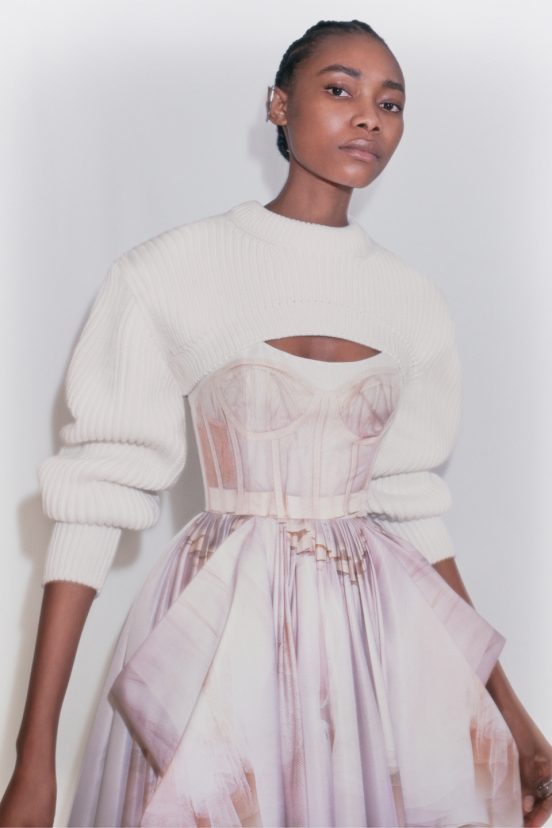Review of Alexander McQueen Spring 2021 Fashion Show ‘First Light’
Back to the Essence
By Long Nguyen
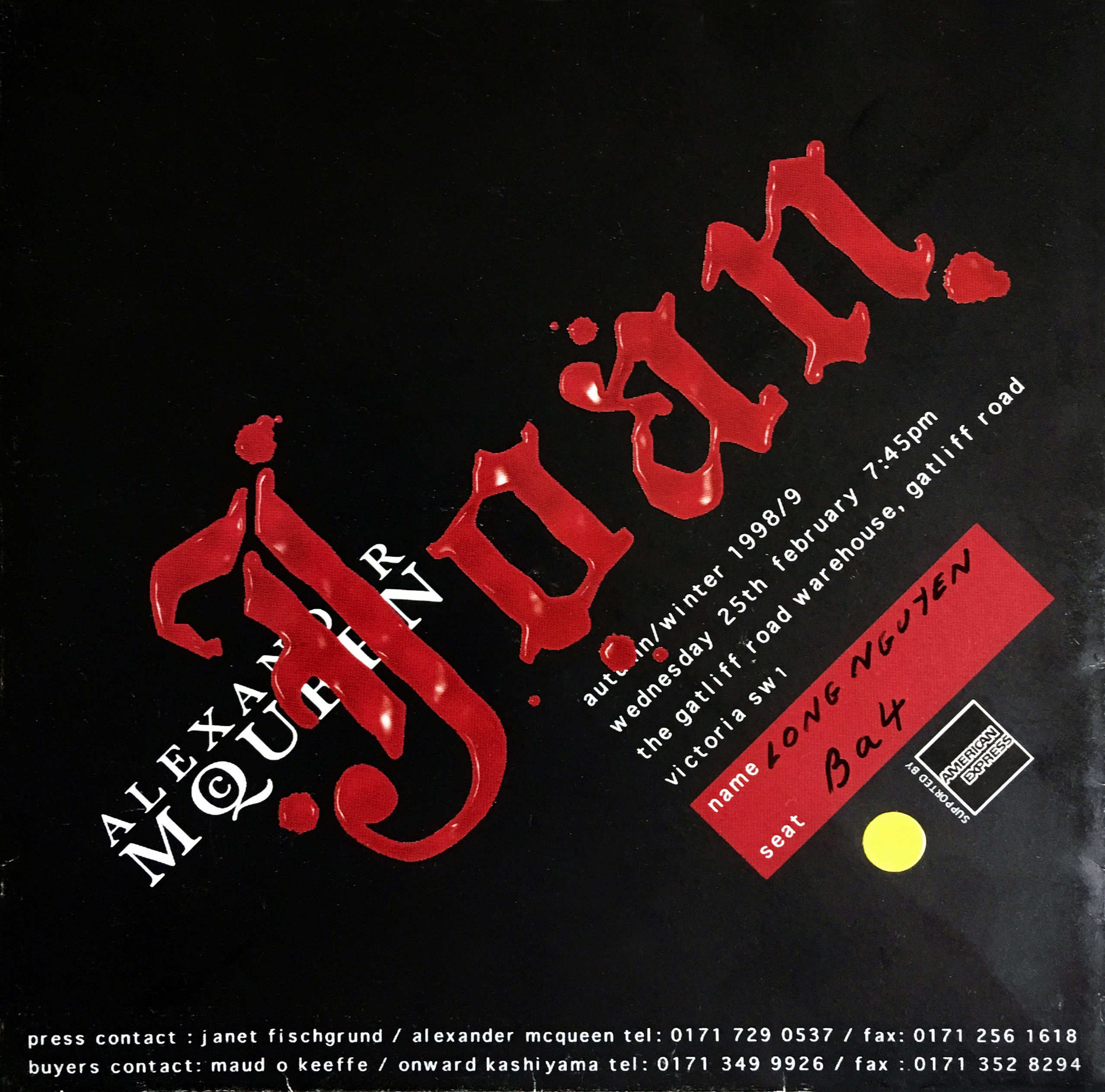
The opening scene of First Light directed by Jonathan Glazer for Alexander McQueen Spring 2021 collection of the two girls walking in the shallow section of the Thames in their cutaway neckline print silk dress with butterfly-draped skirt and chantilly lace corset dress with black dove lace embroidery or of the model sitting on the dirty river silts dressed in a light pink strapless corset dress with layered tulle skirt reminded me of the rawness of the early shows that Lee McQueen wooed his audience in the mid-1990s. Shows like the Alexander McQueen fall 1995 Highland Rape, the Spring 1998 Golden Shower, the Fall 1998 Joan of Arc show, and the Spring 1999 show where robot arms spray-painted Shalom Harlowe white strapless dress with dizzying splashes of black and green paints.
The lurid memories from those early shows are difficult to forget – they live on vividly like living history in all their creative rawness that has not been seen and felt again in fashion.
Those shows and ones I saw form Helmut Lang, Martin Margiela, Tom Ford at Gucci, John Galliano, Yohji Yamamoto, and Rei Kawakubo were the designers that greatly influence my formative years as a fashion editor and those shows to instill in me ever since that very start a sense of what fashion can encompass for a designer and his/her audience. But the far-reaching arc of fashion in those late 1990s years has evolved significantly over these decades – today, the fashion clothes are much less influential than in those hyper-creative days with the kinds of life and let die fashion springing up from a sort of endless underground. The world and fashion have changed in fundamental ways in the last two decades. Values have also evolved.
Now, sometimes the memories of that distant past can be seen again, albeit differently. In this new era, it may seem irresponsible to do anything that may be deemed outrageous. Thus, the heightened drama of the robots spraying Harlowe’s virgin white strapless dress, turning it into a dirty graffiti-laden dress, has given way to the intricate black lace embroidered on the white lace dress, forming a hand brush paint pattern on the dress seen on the model at the opening scene of the film getting her tulle strapless dress wet and slightly dirty by the river’s silt.
Fashion creativity has to correspond to the current values, and it has to change along with the social-cultural manners to be meaningful and impactful in profound ways.
Then more than two decades ago, it was possible to send fire on the rotunda of a stage set or have water coming down onto the runway wetting even the front row guests because designers were working on their own and have to show the kind of fashion living inside their hearts and minds. The branding era has yet to arrive at that stage, but now the fashion environment has evolved, and the fashion business has changed in radical ways, along with what fashion can mean to new audiences. But the fashion experience and how to create that sensorial feel for clothes still matter a great deal.
In this film titled First Light, directed by the English filmmaker Jonathan Glazer who started in theater before moving to motion pictures, the torn laces, faux blood, ripped tartans, and hellfire of yesteryear’s heyday have been replaced by the tranquility of water parted by the models’ soft and slow pacing upstream as they walked along the edges of the river to find a group of others camping underneath a bridge. One girl in a black lace corset dress, smiling, waved to another across the river wearing an ecru hybrid tailor coat dress, signaling the human connection instead of the loneliness and silence of this story of the rediscovery of the human contact.

This film is an effective attempt to create a kind of experience for fashion outside of the citadel of staging a live show with a constructed set resembling the designer’s central idea to get across to the public.
Here, the clear narrative allows the audience to look at the clothes in a real fashion show as the action is more or less non-action. Furthermore, the clothes do not feel out of place or overdone, and the film’s pace allows the audience to look at the clothes worn by the characters.
Fashion designers have to imagine fantasies, either personal or experienced, to make their clothes more than just designer garments, crafting some aesthetics in the collections like infusing regular tea with some red berries fruit. Burton’s clothes are still poetic in their complex constructions and their visual charms.
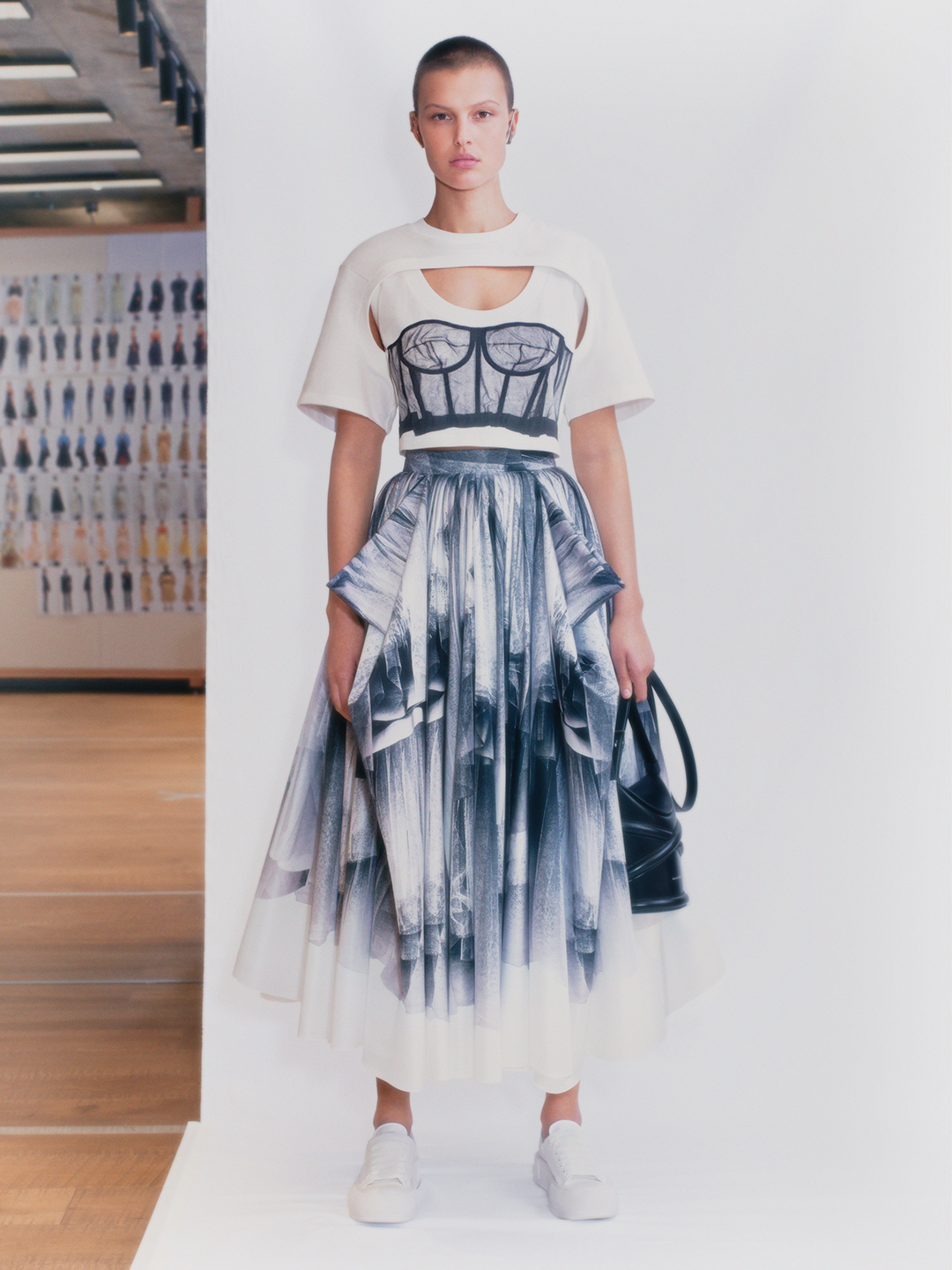
Back to London, coming home. Shape, silhouette, and volume, the beauty of the bare bones of clothing stripped back to its essence – a world charged with emotion and human connection.
– Sarah Burton, Alexander McQueen Creative Director, on the arc of the collection
The heart of the Alexander McQueen brand has always been about this essence of design. Sarah Burton’s work at the McQueen brand combines, on the one hand, the maintenance of the ‘heritage’ look and feel of the brand created under the house’s founder, and on the other, the making of her fashion new but with that familiar aesthetics to her audience and her new consumers who are coming to the house because they want the type of dress or jackets or coats that recalled what McQueen did back in those years.
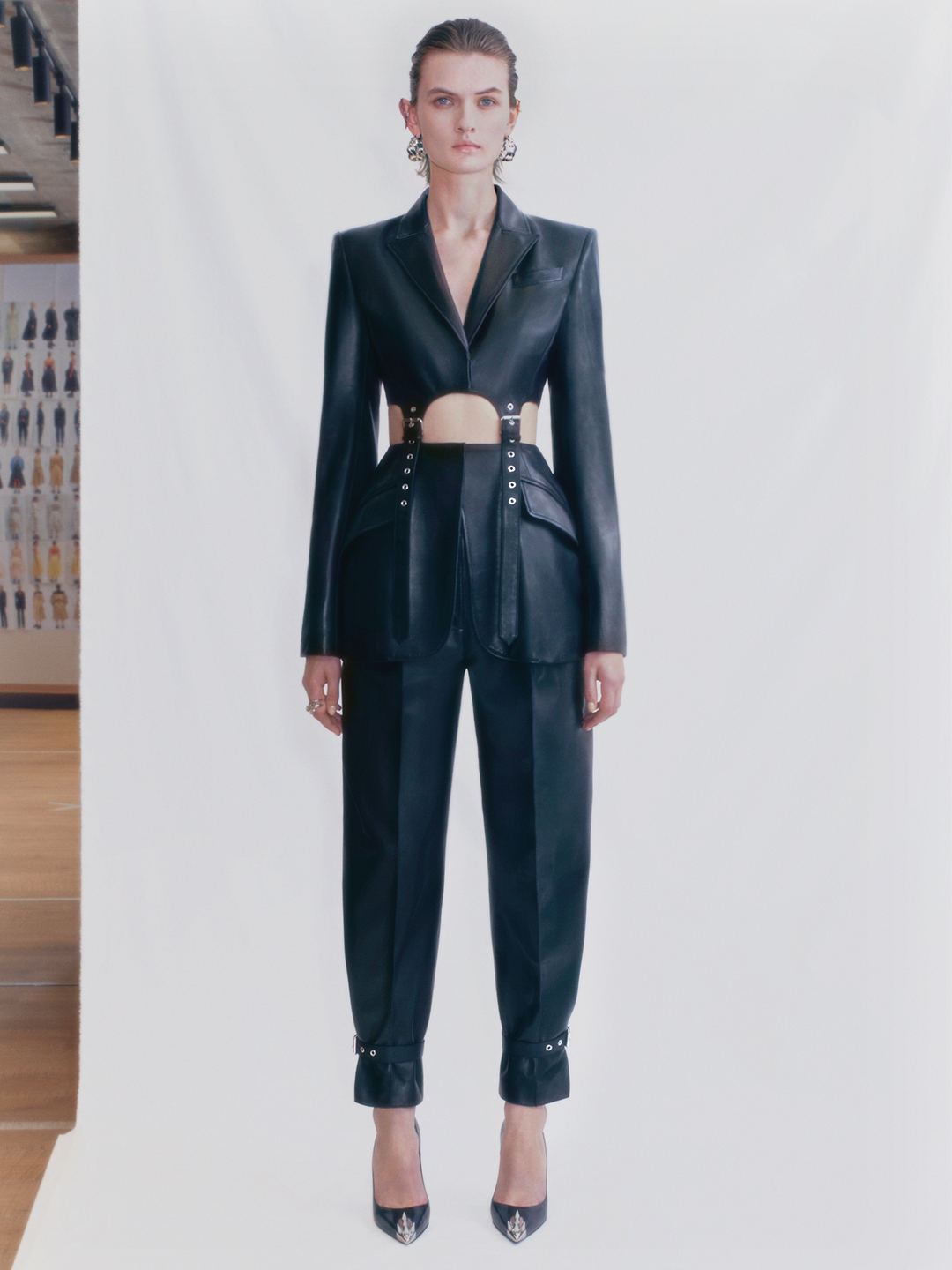
In this respect, Burton excels in both providing new designs with the twists that mark something familiar, and this coming home collection perfectly shows that balance, both delicate at certain times like the white shirt dress with fold sleeves or the white coat dress cut so precisely worn with skinny pants and raw at other times like a black blazer cut out at the waist with a strap and buckle construction and lean pants. Burton also combined the sharp tailoring with the softness of dressmaking in such seamless ways that a light ecru trench looks like a dress more so than a hard shape trench. She now owns the classic black leather biker jacket, the pantsuits, and the trench coat that see new iterations seasons after seasons adding new design by mixing soft and hard elements to create new products. The biker becomes an off-shoulder and open neckline jacket with a matching wrap skirt or a more fanciful version as a sleeveless jacket with tulle peplum and organza puff sleeves.
The sense of control here and is clear in the clothes. For example, a white cropped one-button jacket and tiered lace skirt – it is as if a whole dress of white lace would have been too fancy or dramatic for this moment, now tempered by a clean and simple tailored jacket, both still endowed with that McQueen roots. But controlling creativity isn’t and doesn’t mean limiting how the clothes are designed and made. In fact, the serene sense of creativity permeates throughout each of the outfits created for this collection, either from the more commercial tailored navy double breast four buttons cuffed pantsuit to the khaki trench-dress combination with exploding puff sleeves.

The pre-fall menswear rests on sharp tailoring with slim fitted shapes and strong and narrow shoulder lines on a navy double breast knee-length flare coat with cinched back with or without white logo, trompe l’oeil double-layered bolero-double breast prince of wales fitted pantsuit, and single breast mixed wool layered jacket pantsuit. The tailoring is extended to the cut of the oversized khaki trench coat with kimono sleeves belted at the waist to contrast the volumes and to the perfect ‘tailored’ black leather biker that fit like a glove on the body. The co-ed presentation allows for one aesthetic vision shared by both the men and the women collections.
A few hours before this season’s first major Nor’easter that promised to blanket the Northeast coast and New England with the first major snowstorm, I went to the Alexander McQueen store in Soho to look at some of these spring clothes hang at the store. The khaki trench’s puff sleeves come to life, taking up space for its interplay of volume and fitted shape. The trompe l’oeil single breast jacket reveals the play of volume by faux layering. The black leather biker has that very slight hourglass shape on a hanger. There are a series of men’s suiting, albeit more commercial variations in the back of the store. Clothes in pictures and clothes, in reality, do feel different.
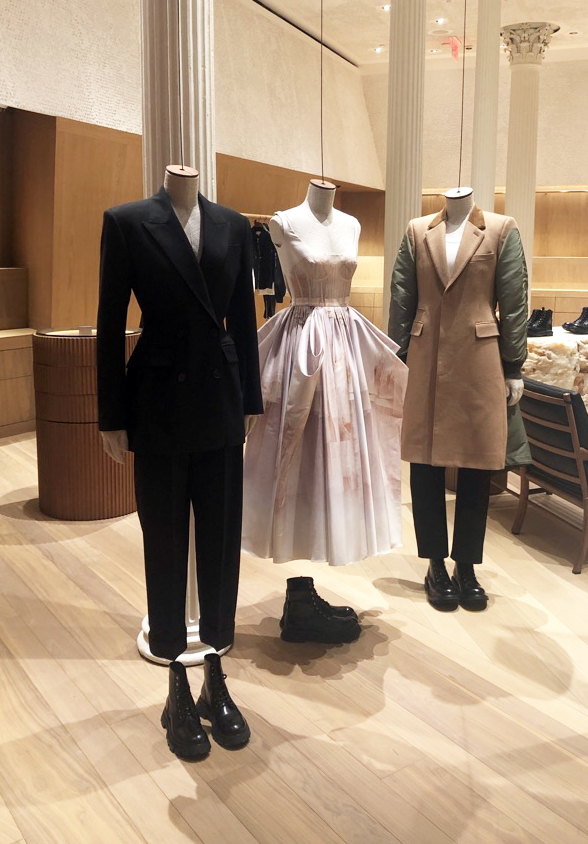
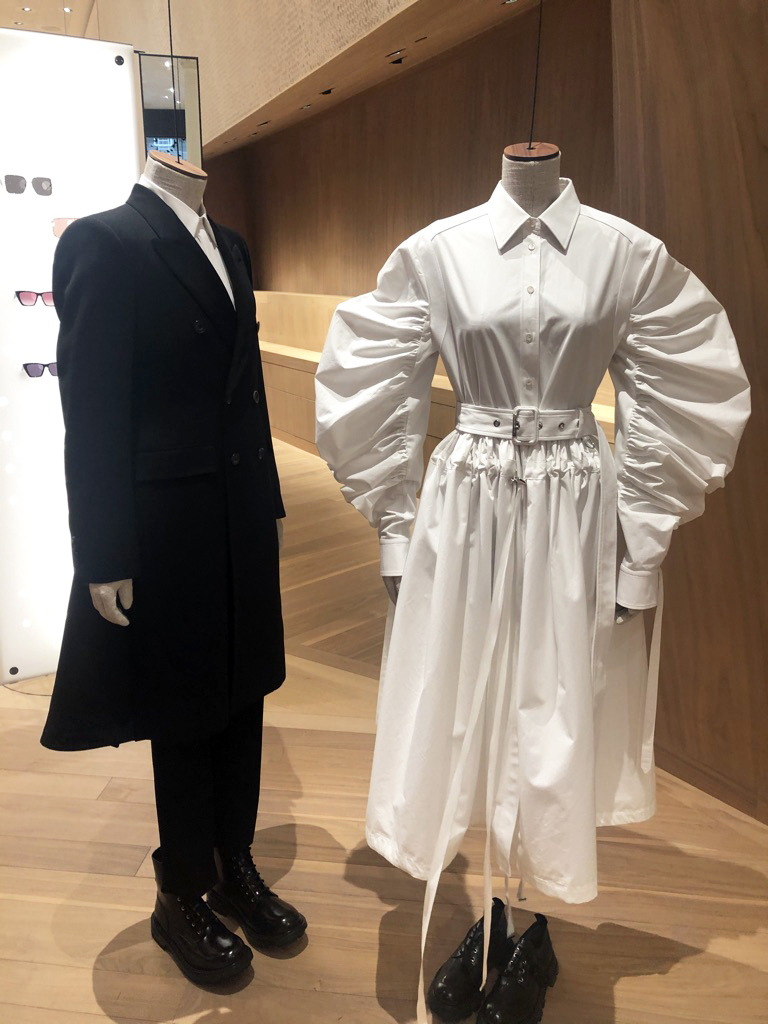

There is no doubt of the mastery of crafts and techniques instilled in each of these spring garments, each with a special treatment as not leaving any garment lacking a sense of genuine design. This may be a crucial ingredient as the McQueen house embarks on a mission of expansion – how to provide the customers with the kind of clothes recognized as from McQueen, clothes that still have that fresh feeling of handiwork and, more importantly, that there is a designer behind the dress or the suit or the biker blouson making each of them look and feel and how it is worn out in real life.
